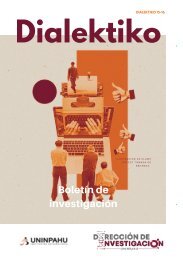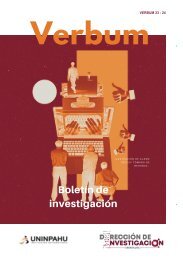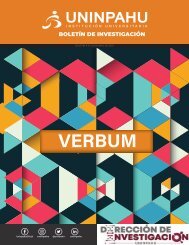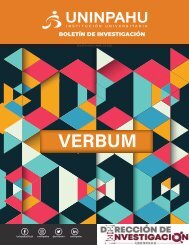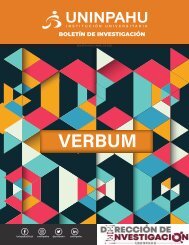Revista UNINPAHU No 9
Revista de investigación UNINPAHU No 9
Revista de investigación UNINPAHU No 9
You also want an ePaper? Increase the reach of your titles
YUMPU automatically turns print PDFs into web optimized ePapers that Google loves.
30 Pp 23 - 31. Nº 9, octubre de 2013<br />
do with the place the building was purposely<br />
constructed on; it faces the intersection of two<br />
very close mountains, which for aboriginals<br />
that first inhabited Bogotá represented the<br />
encounter of the past and the future.<br />
Seeing the visit as a tour of continuous<br />
displacements and orientation movements<br />
through different sites of the edifice and through<br />
different epochs of the Colombian’s history, the<br />
visit presented important confrontations with<br />
students’ previous ideas about history and the<br />
past. In terms of learning about social memory<br />
and how collective memory works, the Archive<br />
visit offered important clues to the Montessori<br />
students’ former knowledge and understandings.<br />
My interpretation is that students’ comments<br />
reflect an interesting confrontation with<br />
perceptions and images of the past that comes out<br />
of unusual encounter with what they as students<br />
do not see often: a place and the people who are<br />
dedicated to work for the past and preservation<br />
of memory.<br />
Amanda 16 years old supports and complements<br />
this idea:<br />
“VISITA AL ARCHIVO GENERAL DE LA<br />
NACION: Esta visita me pareció muy interesante<br />
debido a todos los documentos que existen allí y como se<br />
pudieron recuperar debido a las circunstancias de aseo,<br />
humedad y que muchos de estos están muy deteriorados,<br />
hojas y libros completamente destruidos. El solo hecho<br />
de recuperar tanto patrimonio cultural es un avance<br />
muy grande y también que este establecimiento tenga<br />
un laboratorio de química para crear líquidos para<br />
la reestructuración de todos aquellos documentos,<br />
pero mas impresionante es que a todos estos libros los<br />
protejan de cualquier otro microorganismo que quiera<br />
vivir allí, pero gracias a los químicos que se le aplican<br />
no es posible que ese organismo viva, y así se pueda<br />
conservar por mucho más tiempo.” 19 (Amanda, 16<br />
years old, Diary notes)<br />
Reading Amanda’s notes, I recall as well that the<br />
chemistry laboratory was introduced to us, as a<br />
first aid area in the National Historical Archive.<br />
I remember again our tour guide using the<br />
metaphor of clinical emergencies with documents<br />
that are sent out to the National Archive clinic.<br />
He said that quite often they receive patients in<br />
very critical condition and showed us through a<br />
big glass window National Archive’s employees<br />
dressed up with white coats manipulating papers<br />
and chemicals. He remarked that the purpose<br />
of the chemical process was to keep documents<br />
of the past alive, to assure their existence in the<br />
present, and to preserve them for the future. For<br />
me, the important fact was that right there we<br />
began to understand and learn how to preserve<br />
the past and make it exist longer, or in other<br />
words, how to prevent memory and history from<br />
falling into oblivion and disappearance.<br />
I believe these images and words touched and<br />
left a significant effect on students’ knowledge,<br />
awareness and attitudes towards history and the<br />
past. These images of an archive-hospital where<br />
documents come for repair and preservation<br />
created a powerful environment, a learning<br />
context for the understanding of memory and the<br />
work done on memory: a pedagogical referent<br />
that helps to understand why Amanda was so<br />
impressed by liquids and chemical processes for<br />
the “reestructuración de todos esos documentos” 20 and<br />
the meaning of images linked with the life and<br />
death of archival texts. To me, Amanda’s detailed<br />
reflection on micro-organisms living in books, and<br />
chemicals protecting documents from destruction<br />
is another way to talk about the reconstruction of<br />
the past. It is a powerful metaphor that evokes the<br />
struggles against historical oblivion.<br />
(19) “GENERAL NATIONAL ARCHIVE VISIT: This was a very interesting visit because of all those documents that exist<br />
there and the way they were recovered taking into account hygiene conditions, humidity, and that many of them are<br />
very much deteriorated, papers and books completely destroyed. Just the fact of recovering so much cultural heritage<br />
is a huge progress and also that this Institution had a chemistry laboratory to create liquids for the reconstruction of all<br />
those documents. But most impressive is that all these books are protected from any other micro organism that wants to<br />
live in them, but thanks to the chemicals that are applied it is not possible for that organism to live, and then it is possible<br />
to preserve them [documents] for longer time”.<br />
(20) “reconstruction of all those documents”








